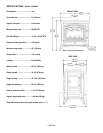
MAINTENANCE / TROUBLESHOOTING
PAGE 23
IN THE EVENT OF A CHIMNEY FIRE
Make sure the fuel loading doors are securely
closed. Adjust the primary air draft control to the
lowest (most closed) setting and ensure that the
start-up air control is closed. Call the fire depart-
ment immediately. After a chimney fire, the complete
chimney system should be checked by a qualified
technician before further use.
Consult your dealer for suggestions on proper chim-
ney care. Contact your local municipal or provincial
fire authority for information on how to handle a
chimney fire. Have a clearly understood plan for han-
dling a chimney fire. Establish a routine for the fuel,
stove and firing technique. Check daily for creosote
build-up until experience shows how often you need
to clean to be safe. Be aware that the hotter the fire
the less creosote is deposited, and weekly cleaning
may be necessary in mild weather even though
monthly cleaning may be enough in the coldest
months.
REINSTALL BAFFLE BRICK
After your chimney has been swept, reinstall the baffle
brick. See – Removing Baffle Plates for Cleaning (on
previous page) and reverse steps.
TROUBLESHOOTING
* When Fuel Door Is Opened, Smoke Enters Room.
1. The primary air draft control is closed.
2. The chimney is too cool. Set the primary air draft con-
trol on "HIGH" for a few minutes before opening either
fuel loading door.
3. Excess creosote will not only restrict your draft but it
will create a risk of a creosote fire. Strictly adhere to
maintenance requirements as outlined in this manual.
If excess creosote has built up on the inside of the
firebox sides and door, burn a small hot fire at inter-
vals that are more frequent with air control on HIGH
for a few minutes.
4. Deposits may have built up in the chimney and are
restricting the draft, or the spark arrester on top of
the chimney may be plugged.
5. Chimney diameter too large or too small to provide
adequate draft.
6. The house is too airtight (usually takes 20 to 30 min-
utes for problem to appear as stove lowers air pres-
sure in house). Crack a window open or provide an
outside source of air near stove.
7. Insufficient vertical height to chimney to achieve ade-
quate draft.
Does Not Produce Enough Heat
1. Using green or insufficiently cured wood.
2. Excessive draft.
3. High ceilings (heat rises quickly, but can be recircu-
lated by a well-placed ceiling fan with a win-
ter/summer switch).
4. The area to heat is too large (square foot heating
estimates are based on "average" climates and
home design).
5. There is an obstruction in the chimney.
6. The chimney or chimney cap is restricted by creo-
sote preventing enough draw to sustain a "high" heat
output rate.
* Does Not Maintain A Fire
1. Soft wood does not burn as long or as well as sea-
soned hardwood resulting in a short burn time.
2. Wood size too small. Burns at too rapid a rate.
3. The gasket seal on the fuel loading doors, or glass is
leaking air. Repair or replace it if necessary.
4. Excessive Draft.
5. There may be an obstruction in the chimney.
* Backpuffing
Definition: This is a term describing the condition
when combustible gases remain unlit because of in-
sufficient combustion air delivery which results in
combustible gases building, then flash igniting. If
backpuffing is occurring, it can push some smoke
into the room through the primary or secondary air
openings. The combustion air delivery is dependent
upon the draft of the venting system. The following
are variables, which can negatively affect the draft
resulting in backpuffing.
1. Downdraft in the chimney (a special wind cap may be
needed).
2. The house is too air tight (ventilation is needed).
3. Insufficient vertical height to chimney to achieve ade-
quate draft.
Odors
1. Creosote accumulation in firebox (brush out on next
cleaning).
2. Chimney downdraft when stove is not operating (close
the primary air draft control).
3. Paint curing on first several burns.
* Dirty Glass
1. Poor draft conditions.
2. Long burn periods at low draft settings.
3. Burning wet, pitchy or spongy wood.
4. Poorly arranged logs (too close to glass).
* Draft problems; if installing into a larger flue, it may
be necessary to use a full-length liner to achieve
adequate draft for the appliance. A draft gauge
should read a minimum of .05" W.C. (inches water
column) not to exceed .06" W.C. for optimum per-
formance (See Draft Requirements on 11).


















